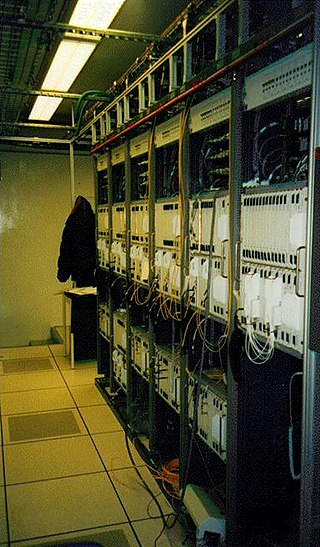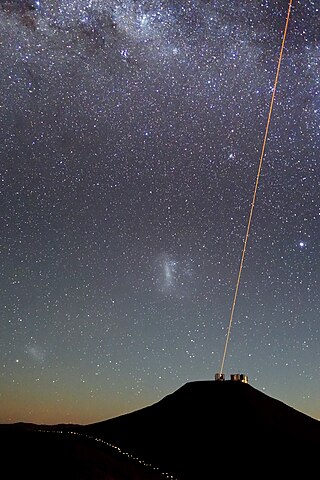Related Research Articles

Synchronous Optical Networking (SONET) and Synchronous Digital Hierarchy (SDH) are standardized protocols that transfer multiple digital bit streams synchronously over optical fiber using lasers or highly coherent light from light-emitting diodes (LEDs). At low transmission rates data can also be transferred via an electrical interface. The method was developed to replace the plesiochronous digital hierarchy (PDH) system for transporting large amounts of telephone calls and data traffic over the same fiber without the problems of synchronization.

An optical amplifier is a device that amplifies an optical signal directly, without the need to first convert it to an electrical signal. An optical amplifier may be thought of as a laser without an optical cavity, or one in which feedback from the cavity is suppressed. Optical amplifiers are important in optical communication and laser physics. They are used as optical repeaters in the long distance fiber-optic cables which carry much of the world's telecommunication links.

A heterodyne is a signal frequency that is created by combining or mixing two other frequencies using a signal processing technique called heterodyning, which was invented by Canadian inventor-engineer Reginald Fessenden. Heterodyning is used to shift signals from one frequency range into another, and is also involved in the processes of modulation and demodulation. The two input frequencies are combined in a nonlinear signal-processing device such as a vacuum tube, transistor, or diode, usually called a mixer.

In telecommunications, a network interface device is a device that serves as the demarcation point between the carrier's local loop and the customer's premises wiring. Outdoor telephone NIDs also provide the subscriber with access to the station wiring and serve as a convenient test point for verification of loop integrity and of the subscriber's inside wiring.
TAT-8 was the 8th transatlantic communications cable and first transatlantic fiber-optic cable, carrying 280 Mbit/s between the United States, United Kingdom and France. It was constructed in 1988 by a consortium of companies led by AT&T Corporation, France Télécom, and British Telecom. AT&T Bell Laboratories developed the technologies used in the cable. The system was made possible by opto-electric-opto regenerators acting as repeaters with advantages over the electrical repeaters of former cables. They were less costly and could be at greater spacing with less need for associated hardware and software. It was able to serve the three countries with a single transatlantic crossing with the use of an innovative branching unit located underwater on the continental shelf off the coast of Great Britain. The cable lands in Tuckerton, New Jersey, USA, Widemouth Bay, England, UK, and Penmarch, France.

In fiber-optic communications, wavelength-division multiplexing (WDM) is a technology which multiplexes a number of optical carrier signals onto a single optical fiber by using different wavelengths of laser light. This technique enables bidirectional communications over a single strand of fiber as well as multiplication of capacity.

Optical communication, also known as optical telecommunication, is communication at a distance using light to carry information. It can be performed visually or by using electronic devices. The earliest basic forms of optical communication date back several millennia, while the earliest electrical device created to do so was the photophone, invented in 1880.

Photonics is a branch of optics that involves the application of generation, detection, and manipulation of light in the form of photons through emission, transmission, modulation, signal processing, switching, amplification, and sensing. Photonics is closely related to quantum electronics, where quantum electronics deals with the theoretical part of it while photonics deal with its engineering applications. Though covering all light's technical applications over the whole spectrum, most photonic applications are in the range of visible and near-infrared light. The term photonics developed as an outgrowth of the first practical semiconductor light emitters invented in the early 1960s and optical fibers developed in the 1970s.

Signal refers to both the process and the result of transmission of data over some media accomplished by embedding some variation. Signals are important in multiple subject fields including signal processing, information theory and biology.

A regenerative circuit is an amplifier circuit that employs positive feedback. Some of the output of the amplifying device is applied back to its input to add to the input signal, increasing the amplification. One example is the Schmitt trigger, but the most common use of the term is in RF amplifiers, and especially regenerative receivers, to greatly increase the gain of a single amplifier stage.

Extended Resolution Compact Disc (XRCD) is a mastering and manufacture process patented by JVC for producing Red Book compact discs. It was first introduced in 1995.
Neural engineering is a discipline within biomedical engineering that uses engineering techniques to understand, repair, replace, or enhance neural systems. Neural engineers are uniquely qualified to solve design problems at the interface of living neural tissue and non-living constructs.
Raman amplification is based on the stimulated Raman scattering (SRS) phenomenon, when a lower frequency 'signal' photon induces the inelastic scattering of a higher-frequency 'pump' photon in an optical medium in the nonlinear regime. As a result of this, another 'signal' photon is produced, with the surplus energy resonantly passed to the vibrational states of the medium. This process, as with other stimulated emission processes, allows all-optical amplification. Optical fiber is today most used as the nonlinear medium for SRS for telecom purposes; in this case it is characterized by a resonance frequency downshift of ~11 THz. The SRS amplification process can be readily cascaded, thus accessing essentially any wavelength in the fiber low-loss guiding windows. In addition to applications in nonlinear and ultrafast optics, Raman amplification is used in optical telecommunications, allowing all-band wavelength coverage and in-line distributed signal amplification.

An optical fiber, or optical fibre, is a flexible glass or plastic fiber that can transmit light from one end to the other. Such fibers find wide usage in fiber-optic communications, where they permit transmission over longer distances and at higher bandwidths than electrical cables. Fibers are used instead of metal wires because signals travel along them with less loss and are immune to electromagnetic interference. Fibers are also used for illumination and imaging, and are often wrapped in bundles so they may be used to carry light into, or images out of confined spaces, as in the case of a fiberscope. Specially designed fibers are also used for a variety of other applications, such as fiber optic sensors and fiber lasers.
An optical communications repeater is used in a fiber-optic communications system to regenerate an optical signal. Such repeaters are used to extend the reach of optical communications links by overcoming loss due to attenuation of the optical fiber. Some repeaters also correct for distortion of the optical signal by converting it to an electrical signal, processing that electrical signal and then retransmitting an optical signal. Such repeaters are known as optical-electrical-optical (OEO) due to the conversion of the signal. These repeaters are also called regenerators for the same reason.
An optical cross-connect (OXC) is a device used by telecommunications carriers to switch high-speed optical signals in a fiber optic network, such as an optical mesh network.

An optical transport network (OTN) is a digital wrapper that encapsulates frames of data, to allow multiple data sources to be sent on the same channel. This creates an optical virtual private network for each client signal.

Fiber-optic communication is a method of transmitting information from one place to another by sending pulses of infrared or visible light through an optical fiber. The light is a form of carrier wave that is modulated to carry information. Fiber is preferred over electrical cabling when high bandwidth, long distance, or immunity to electromagnetic interference is required. This type of communication can transmit voice, video, and telemetry through local area networks or across long distances.
The Mamyshev 2R regenerator is an all-optical regenerator used in optical communications. In 1998, Pavel V. Mamyshev of Bell Labs proposed and patented the use of the self-phase modulation (SPM) for single channel optical pulse reshaping and re-amplification. More recent applications target the field of ultrashort high peak-power pulse generation.

Optically stimulated luminescence (OSL) thermochronometry is a dating method used to determine the time since quartz and/or feldspar began to store charge as it cools through the effective closure temperature. The closure temperature for quartz and Na-rich K-feldspar is 30-35 °C and 25 °C respectively. When quartz and feldspar are beneath the earth, they are hot. They cool when any geological process e.g. focused erosion causes their exhumation to the earth surface. As they cool, they trap electron charges originating from within the crystal lattice. These charges are accommodated within crystallographic defects or vacancies in their crystal lattices as the mineral cools below the closure temperature.
References
- ↑ "signal regeneration". Federal Standard 1037. Retrieved Nov 21, 2008.